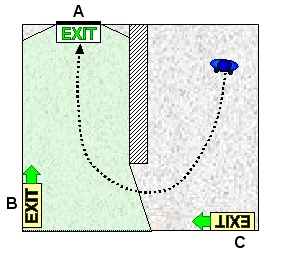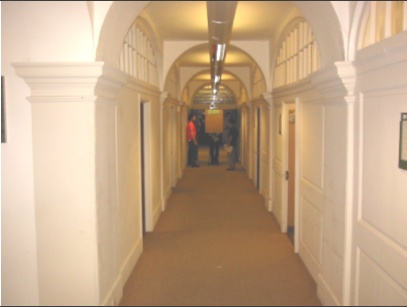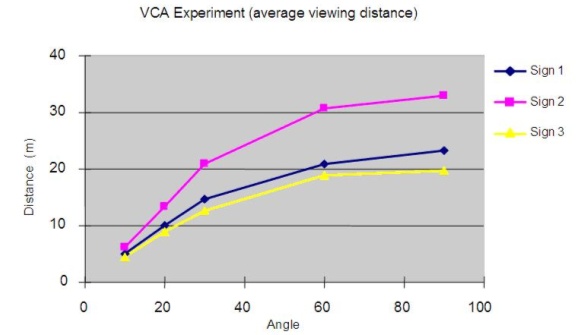Signage Legibility Distances as a Function of Viewing Angle
This project is concerned with determining the viewing distance from which signs are legible. This distance is intended to represent the minimum distance from which the information conveyed by the sign can be interpreted by an observer. It is important to note that this work does not include recognition of pictograms on signage. Recognition of pictograms is expected to occur at greater distances than the legibility distance. Thus, the legibility distance represents a conservative or lower limit of the recognition distance.
 |
 |
| Figure 1: Signage system utilising in wayfinding | Figure 2: Viewing a sign at an angle |
Signage systems are widely used in complex buildings to provide information for efficient wayfinding (see figure 1). Safety signs that indicate specific routes and actions for evacuation are particularly important to the occupants in an emergency situation. To ensure reliable recognition and comprehension of signage information, safety signs are required to conform to certain design criteria specified in various national and international standards and guideline documents. According to these documents there are usually some basic requirements which depend on the size of the sign, size of the premises and the intended use of premises. These design criteria, for example as specified in BS5499 Part 1 1990, are generally based on data from eyesight tests and define viewing distances as a function of the letter height. These are generally based on viewing the sign straight on. In reality, occupants may approach a sign at various angles making the sign more difficult to resolve (see figure 2). This influence on sign legibility has been virtually ignored to date however, it is an important consideration when introducing sign recognition and interpretation into evacuation models such as buildingEXODUS.
A new concept introduced into the buildingEXODUS evacuation software is Visibility Catchment Area (VCA). This is the region over which it is physically possible to see the sign. The termination distance for the VCA is currently arbitrarily set as the distance specified in regulations. As described above, this does not take into account approaching the sign at an angle. In this project the angular dependence of the termination distance is explored experimentally using volunteers.
 |
|
Figure 3: Sign used in experiment |
The experiment is performed in a long corridor with consistent illumination (see figure 3). Three signs varying in letter height (see figure 4) are placed successively on a white board at a fixed height. During the trials a series of pre-determined angles are set to the board relatively to the centre line of the corridor. A participant from a representative sample of the general public is led to the far end of corridor and is then asked to move towards the sign until they are able to clearly resolve half the letters in the sign. The distances between the participant and the sign are then measured and recorded and later analysed.

Figure 4: Three typical fire safety signs in different size
The experimental data collected thus far clearly shows the dependence of maximum viewing distance on viewing angle (see figure 5) for all three sign sizes.

Figure 5: The average viewing distance extracted from the experimental data
Reference:
“Simulating the Interaction of Pedestrians with Wayfinding Systems.”. Filippidis L., Gwynne S., Galea E.R., and Lawrence P. Proc 2nd Int Pedestrian and Evacuation Dynamics Conference, Ed: E.R.Galea, CMS Press, Greenwich, UK, ISBN 1904521088, pp39-50, 2003.

